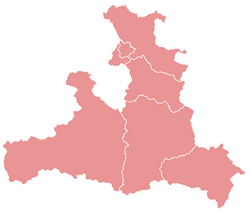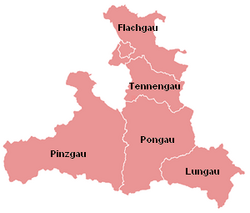| Salzburg | |||
|---|---|---|---|
| — State of Austria — | |||
|
|||
| Country | |||
| Capital | Salzburg | ||
| Government | |||
| • Governor | Gabi Burgstaller (SPÖ) | ||
| Area | |||
| • Total | 7,156.03 km2 (2,762.96 sq mi) | ||
| Population | |||
| • Total | 531,800 | ||
| • Density | 74/km2 (190/sq mi) | ||
| Time zone | CET (UTC+1) | ||
| • Summer (DST) | CEST (UTC+2) | ||
| ISO 3166 code | AT-5 | ||
| NUTS Region | AT3 | ||
| Votes in Bundesrat | 4 (of 62) | ||
| Website | www.salzburg.gv.at | ||

Districts of Salzburg.
Salzburg (pronounced [ˈzaltsbʊʁk]; Austro-Bavarian: Såizburg; literally: "Salt Castle") is a state or Land of Austria with an area of 7,156 km2, located adjacent to the German border. It is also known as Salzburgerland, to distinguish it from its capital city, also named Salzburg. With 529,085 inhabitants it is one of the country's smaller states in terms of population.
Geography[]
Location[]
The Salzburger Land (the Austrian state of Salzburg) — with its primary river, the Salzach — lies between Upper Austria, Styria, Carinthia, Tyrol, South Tyrol (Italy) and Bavaria (Germany).
Running through the south are the main ranges of the Central Alps (incl. the Hohe Tauern mountains) with numerous 3,000m peaks. The Dachstein Massif and the Berchtesgaden Alps border the Salzburger Land to the east and north.
Major cities and towns[]
|
|
History[]
Salt has played an important role in the region's development; Salzburg means "salt castle".
Salzburg as an independent country[]
Independence from Bavaria was secured in the late 14th century. The Archbishopric of Salzburg was an independent prince-bishopric within the Holy Roman Empire until German Mediatisation in 1813.
Electorate of Salzburg[]
The territory was secularized and, as the Electorate of Salzburg, given as compensation to Ferdinand III, former Grand Duke of Tuscany, the brother of Emperor Francis II.
The end of the independence[]
Following the Austrian defeat at Austerlitz in 1805, Salzburg was annexed by Austria as compensation for the loss of Tyrol to the Kingdom of Bavaria, and Ferdinand was transferred to the Grand Duchy of Würzburg.
Bavarian Salzburg[]
After Austria's defeat in 1809, the province was handed over to Bavaria in 1810.
The country divided between Bavaria and Austria[]
In 1816, following the defeat of Napoleon and the provision of adequate compensation to Bavaria at the Congress of Vienna, it was returned to Austria with the exception of the north-western 'Rupertigau' which remained Bavarian. The Salzburger Land was administered as the department of Salzach from Linz, the capital of Upper Austria. In 1849 the Duchy of Salzburg was established as a crownland of the Austrian Empire and, after 1866, Austria-Hungary.
World War I[]
Salzburg participated in World War I, as part of the Austro-Hungarian Empire. 49,000 Salzburgers were called to arms, of whom 6,000 were killed.[1]
Post-WWI Austrian Republics[]
In 1918 after World War I, the Duchy of Salzburg was dissolved and replaced with the State of Salzburg, as a component part initially of German Austria and subsequently of the First Republic of Austria, the separate state which was mandated by the Allied powers. (However, in the November Plebiscite 99% of Salzburgers voted in favor of union with Germany.)
Salzburg in Germany[]
After the plebiscite of 1938, Salzburg and all the territory of Austria decided to belong to the German Reich.
American control[]
After the defeat of Nazi Germany in 1945, the Allies occupied the territory of Austria, being recognised as an independent territory under their rule. Salzburgerland was occupied by the United States.
Salzburg as an Austrian State[]
In 1955 Austria was declared independent of the Allies and Salzburg was once again one of the reconstituted federal-states of the second Republik Österreich.
Politics[]
Salzburgerland has its own constitution since 1999, and the government is formed through a Majority system. The election are every five years.
The last results, in March 2009 (compared to 2004) were:
- Social Democrats (SPÖ): 15 seats (-2)
- People's Party (ÖVP): 14 seats
- Freedom Party (FPÖ): 5 seats (+2)
- The Greens (Grüne): 2 seats
Simon Illner (ÖVP) is the President of the Salzburger Parliament and Gabi Burgstaller (SPÖ) is the president of the Salzburgerland.
Areas of the State President[]
- Markets policy matters
- the directorate of regional offices (Landesamtsdirektion)
- the cabinet – including powers for dealing with catastrophes
- the fire brigades
- science
- innovation and research
- education and schools
- subjects specifically related to women
- European affairs.[2]
The government[]
Deputy-President Wilfried Haslauer (ÖVP)[]
- Economy and tourism
- management research
- transport
- building industry
- municipality administration
- museums
- special cultural projects.
Deputy-President David Brenner (SPÖ)[]
- Administration of finance and capital
- the arts
- sport
Other members of the government[]
- Sepp Eisl (ÖVP): a management and river regulation, energy, staff management and administrative reform.
- Walter Blachfellner (SPÖ): housing, water protection, consumer protection, trade, environment protection, regional development planning.
- Doraja Erbele (ÖVP): young people, family, children, senior citizens, national parks, municipal development, cultural heritage, integration, popular culture.
- Erika Schare (SPÖ): social affairs, homes and institutions run by Land Salzburg as well as health including the hospitals and clinics under the jurisdiction of Land Salzburg.[3]
European results[]
In the most recent elections for the European Parliament, in June 2009, these were the results from the state of Salzburg:
Party Average Austrian People's Party (ÖVP) bgcolor=Template:Austrian People's Party/meta/color| 32.06% Hans-Peter Martin's List 21.08% Social Democratic Party of Austria (SPÖ) bgcolor=Template:Social Democratic Party of Austria/meta/color| 19.09% Freedom Party of Austria (FPÖ) bgcolor=Template:Freedom Party of Austria/meta/color| 12.08% Austrian Greens (Die Grünen) bgcolor=Template:The Greens – The Green Alternative/meta/color| 10.12% Alliance for the Future of Austria (BZÖ) bgcolor=Template:Alliance for the Future of Austria/meta/color| 4.37% Young Liberals (JuLis) bgcolor=Template:Liberal Forum/meta/color| 0.64% Communist Party of Austria (KPÖ) bgcolor=Template:Communist Party of Austria/meta/color| 0.56%
Administrative divisions[]

Map of the districts of Salzburg
Districts[]
Salzburg comprises five districts, known as Bezirke or vernacularly Gaue:
- Pinzgau (district capital in Zell am See)
- Pongau (Sankt Johann im Pongau)
- Lungau (Tamsweg)
- Tennengau (Hallein)
- Flachgau/Bezirk Salzburg und Umgebung (Salzburg and environs)
The city of Salzburg is its own administrative district.
Municipalities[]
The state is divided into 119 municipalities, including Salzburg. 11 of them have city status (Städte), 24 are market towns (Marktgemeinden) and the other 84 are simple municipalities (Gemeinden). Below it is shown a list of all the municipalities divided per district:
- Hallein District (Tennengau) (13 municipalities): Abtenau, Adnet, Annaberg-Lungötz, Bad Vigaun, Golling an der Salzach, Hallein, Krispl, Kuchl, Oberalm, Puch bei Hallein, Rußbach am Paß Gschütt, Sankt Koloman, Scheffau am Tennengebirge.
- Salzburg-Umgebung District (Flachgau) (37 municipalities): Anif, Anthering, Bergheim, Berndorf, Bürmoos, Dorfbeuern, Ebenau, Elixhausen, Elsbethen, Eugendorf, Faistenau, Fuschl am See, Großgmain, Göming, Grödig, Hallwang, Henndorf, Hintersee, Hof bei Salzburg, Koppl, Köstendorf, Lamprechtshausen, Mattsee, Neumarkt am Wallersee, Nußdorf am Haunsberg, Oberndorf bei Salzburg, Obertrum, Plainfeld, Sankt Georgen, Sankt Gilgen, Schleedorf, Seeham, Seekirchen, Straßwalchen, Strobl, Thalgau, Wals-Siezenheim.
- St. Johann im Pongau District (Pongau) (25 municipalities): Altenmarkt im Pongau, Bad Gastein, Bad Hofgastein, Bischofshofen, Dorfgastein, Eben im Pongau, Filzmoos, Flachau, Forstau, Goldegg, Grossarl, Hüttau, Hüttschlag, Kleinarl, Mühlbach am Hochkönig, Pfarrwerfen, Radstadt, Sankt Johann im Pongau, Sankt Martin am Tennengebirge, Sankt Veit im Pongau, Schwarzach im Pongau, Untertauern, Wagrain, Werfen, Werfenweng.
- Tamsweg District (Lungau) (15 municipalities): Göriach, Lessach, Mariapfarr, Mauterndorf, Muhr, Ramingstein, Sankt Andrä im Lungau, Sankt Margarethen im Lungau, Sankt Michael im Lungau, Tamsweg, Thomatal, Tweng, Unternberg, Weißpriach, Zederhaus.
- Zell am See District (Pinzgau) (28 municipalities): Bramberg am Wildkogel, Bruck an der Großglocknerstraße, Dienten am Hochkönig, Fusch an der Großglocknerstraße, Hollersbach im Pinzgau, Kaprun, Krimml, Lend, Leogang, Lofer, Maishofen, Maria Alm, Mittersill, Neukirchen am Großvenediger, Niedernsill, Piesendorf, Rauris, Saalbach-Hinterglemm, Saalfelden, Sankt Martin bei Lofer, Stuhlfelden, Taxenbach, Unken, Uttendorf, Viehhofen, Wald im Pinzgau, Weißbach bei Lofer, Zell am See.
Architecture[]
The Salzburg Cathedral was the first Baroque building in the German-speaking artistic world. Two other important buildings initiated by the Salzburg archbishops were Hohenwerfen Castle and Hohensalzburg Fortress. The first Archbishop of Salzburg was Arno of Salzburg (785-821), in whose honor the world-famous hiking circuit — the Arnoweg — is named.
The predominant stylistic elements of Salzburg architecture have their origins in the Baroque and the Rococo periods.
Salzburg's historic "Old Town" was named by UNESCO as a World Heritage Site.
Language[]
Austrian German is the local written language, and it can be heard, especially in the cities. Austro-Bavarian is also spoken, especially in the rural areas and the common language of the Land Salzburg.
Visitors' attractions[]
- Großglockner Hochalpenstraße: a panoramic road, called Grossglockner High Alpine Road
- Salzkammergut: a lake district belonging to Salzburg, Upper Austria and Styria
- Liechtensteinklamm: Salzburg is home to one of the longest and deepest gorges of the Alps, the Liechtensteinklamm. It is located near Sankt Johann im Pongau or St.Johann/Pg., a small town in the middle of the state.
Sports[]
- Salzburgring, a permanent racing circuit, north east of the city of Salzburg
- Ski Amadé
- Kitzsteinhorn, skiing the year round on a glacier
- Icespeedway in St. Johann im Pongau
Ski resorts[]
Altenmarkt im Pongau, Flachau, Wagrain, St. Johann, Zell am See (Saalbach-Hinterglemm), Obertauern, Bad Gastein, Rauris, Lofer
Assorted Statistics[]
|
|
Accommodation[]
See also[]
- Salzburg
- Archbishopric of Salzburg
References[]
- ^ http://www.salzburg.gv.at/en/en-index/en-geschichtesbg/en-1816.htm
- ^ [salzburg.gov.at]
- ^ Salzburgerland Government
External links[]
- Salzburg State Tourist Board
- Salzburg State Government
- Salzburg Travel Guide with entries for all municipalities
- Pictures from Salzburg
Template:Cities and districts of Salzburg (state)
| This page uses content from the English language Wikipedia. The original content was at Salzburg (state). The list of authors can be seen in the page history. As with this Familypedia wiki, the content of Wikipedia is available under the Creative Commons License. |



